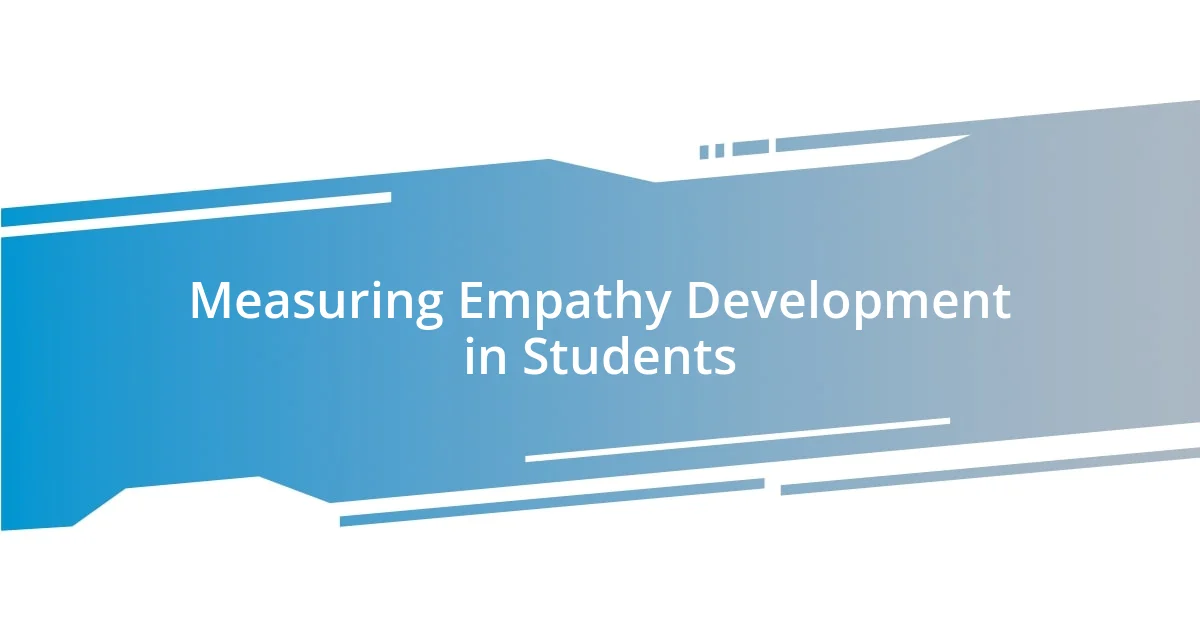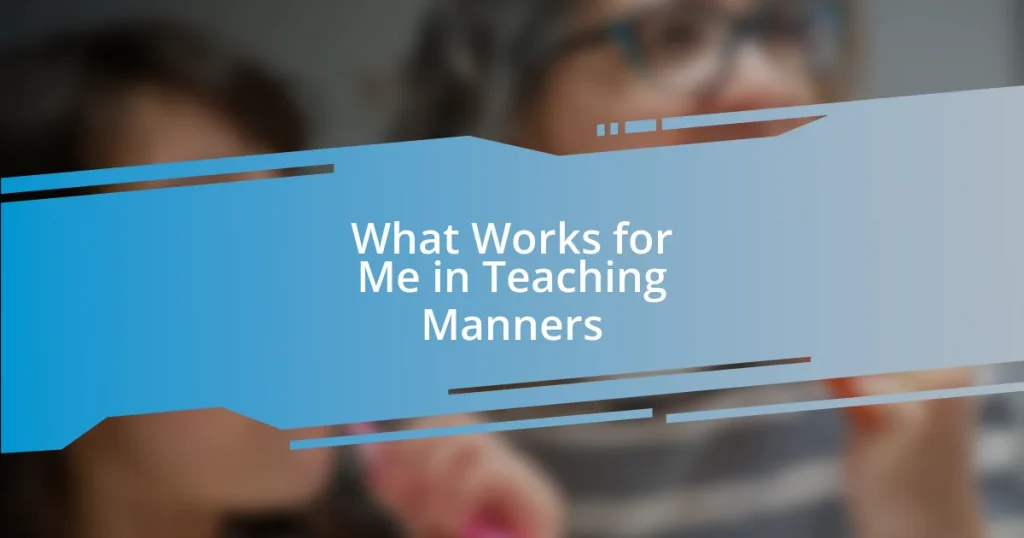Key takeaways:
- Empathy enhances student engagement and fosters a culture of kindness, as seen when a shy student thrived after feeling acknowledged by peers.
- Teaching empathy develops essential life skills such as conflict resolution and social responsibility, demonstrated through student support during challenging scenarios.
- Integrating empathy into various subjects through storytelling, community service, and collaborative projects creates meaningful connections and prepares students for real-world complexities.

Understanding Empathy in Education
Empathy in education isn’t just an abstract concept; it’s a crucial skill that can shape how students interact with one another and the world around them. I often reflect on a moment in my classroom when a student approached me, distressed over a conflict with a friend. This opened a door for a heartfelt discussion about feelings and perspectives, highlighting how empathy can bridge divides.
Have you ever considered the impact of a simple act of understanding on a student’s confidence? I remember a shy student who flourished when his classmates acknowledged his feelings during a group project. It was as if a light bulb turned on—he felt seen, and that acknowledgment transformed his engagement. When students learn to practice empathy, they not only enhance their emotional intelligence but also build a classroom culture of kindness and cooperation.
Moreover, embedding empathy in education encourages students to tackle real-world issues. Take social justice discussions, for instance. When students step into someone else’s shoes, they can grasp the complexities of diverse experiences. This perspective-taking fosters a deeper connection to their communities and empowers them to advocate for change, making empathy a powerful educational tool.

Importance of Teaching Empathy
Empathy is vital in education because it cultivates relationships built on trust and respect. I once witnessed a transformative moment when a student chose to support another who was struggling with personal issues. Afterward, that supportive student expressed how rewarding it felt to be there for someone else, which highlighted to me just how meaningful these connections can be, not only for the individuals involved but for the entire class dynamic.
In my experience, teaching empathy can significantly enhance conflict resolution skills. I recall a situation where a group of students clashed over differing opinions during a project. By guiding them to understand each other’s perspectives instead of emphasizing the disagreements, they successfully navigated their issues and emerged with a stronger bond and mutual respect. It’s fascinating how teaching empathy can turn contentious moments into opportunities for growth.
Ultimately, fostering empathy prepares students for the complexities of the real world. I’ve seen my students engage in community service projects, where they truly connect with those they help. This type of service learning doesn’t just teach them about empathy; it inspires a commitment to social responsibility. Witnessing their growth in understanding and compassion is a heartening reminder of why empathy should be at the forefront of our teaching strategies.
| Aspect | Importance of Teaching Empathy |
|---|---|
| Building Relationships | Encourages trust and respect among peers |
| Conflict Resolution | Enhances skills for effective communication and problem-solving |
| Social Responsibility | Fosters connection to community and commitment to service |

Effective Strategies for Teaching Empathy
Teaching empathy effectively requires a blend of strategies that resonate with students’ emotions and experiences. One approach that has worked well for me is using storytelling. I once shared a poignant story about a historical figure who faced prejudice, which ignited a passionate discussion among my students. As they related to the character’s struggles, I could see their eyes light up with understanding—they began to see the world through another’s lens. This emotional connection is essential; it anchors their learning and makes the concept of empathy more tangible and relatable.
Here are some strategies I’ve found effective for teaching empathy:
- Role-Playing: Engaging students in role-play scenarios allows them to step into someone else’s shoes, promoting deeper understanding of varied perspectives.
- Discussing Emotions: Regularly initiating conversations about feelings—be it through books or current events—helps students articulate and recognize emotions in themselves and others.
- Community Involvement: Encouraging students to participate in community service allows them to interact with diverse groups, fostering compassionate relationships and social responsibility.
- Reflective Journaling: Having students write about their thoughts on empathy can promote self-reflection and deepen their emotional insight.
- Mindfulness Practices: Incorporating mindfulness exercises into lessons can help students center themselves, creating an emotional space to engage with others positively.
Through these strategies, I’ve witnessed firsthand the profound impact empathy can have on my students’ learning experiences and personal growth. The discussions that arise from them are often the most enlightening moments in my classroom, revealing just how powerful empathy can be in creating an understanding and supportive environment.

Integrating Empathy into Curriculum
Integrating empathy into the curriculum is not merely an added bonus; it’s a vital component that should permeate every subject. For instance, during a science lesson on environmental issues, I once encouraged my students to imagine the experiences of those affected by natural disasters. Asking them to think, “How would you feel if this happened in your community?” led to a deeper, more passionate discussion. It was remarkable to see them connect scientific facts with real emotions, bridging understanding with compassion.
In literature classes, I often have students read novels featuring complex characters facing moral dilemmas. One particular book sparked a lively debate when a student passionately defended a character’s questionable choices. This moment reminded me how narratives can cultivate empathy; compelling stories invite readers to walk alongside characters, fostering a genuine understanding of their struggles. Isn’t it fascinating how literature can create such emotional depth and spark conversations that linger long after the book is closed?
Moreover, integrating group projects that require collaboration can cultivate empathy in action. I remember a project where students worked together to design a charity event. They had to listen and respect each other’s ideas while also considering the needs of the community they aimed to help. It was in these moments that I observed budding relationships and shared excitement—students finding joy in understanding each other’s perspectives. Seeing them rally around a common goal reinforced my belief that empathy can be woven seamlessly into the fabric of every lesson plan. How else can we prepare students for a world that thrives on connection and understanding?

Activities to Foster Empathy Skills
One activity I’ve enjoyed incorporating into my classroom is the “Empathy Walk.” In this exercise, students partner up and share a personal story or experience that was impactful for them. As they walk around the school grounds, I encourage them to actively listen and reflect on the feelings conveyed. It’s fascinating to watch how sharing personal narratives can create a bond, allowing students to realize that everyone carries their own baggage. Have you ever noticed how open conversations can bridge gaps between individuals? That’s the magic I observe each time we do this.
Another powerful approach is to use art as a medium for empathy. I once guided my students to create collages depicting what “home” means to them, but I also asked them to craft a separate piece representing a perspective they aren’t familiar with. The discussions that sprung from our art reveal were heartwarming—students expressed vulnerability as they explored unfamiliar feelings and experiences. I often wonder how different our world would be if everyone took the time to understand each other’s views through such creative endeavors.
Finally, I’ve utilized the technique of “Empathy Mapping,” where students visualize and share what they believe others think, feel, and say in different scenarios—like moving to a new school or dealing with loss. It’s incredible to see how this exercise cultivates awareness of emotions in a structured way. As students brainstormed and discussed, I could see those “lightbulb moments” where they suddenly understood perspectives vastly different from their own. Isn’t it amazing how a simple map can lead to profound understanding?

Measuring Empathy Development in Students
Measuring empathy development in students can be a nuanced process, but I’ve found a few effective strategies. One method that stands out to me is using reflective journals where students document their thoughts and feelings about various empathy-related activities. I remember one student wrote about their change in perspective after our “Empathy Walk,” noting how much more connected they felt to their classmates. It’s amazing how simple reflections can reveal growth over time.
Another approach is to utilize peer feedback sessions. In one instance, I facilitated a discussion where students shared their experiences from an empathy-building project. It was heartening to hear them articulate how they perceived each other’s feelings and contributions. This peer interaction not only fosters a supportive environment but also allows for honest evaluations, highlighting growth in empathy among students. Have you ever noticed how we often learn the most when we listen to others’ insights?
Additionally, assessments can take the form of role-playing scenarios. I vividly recall a day when students stepped into each other’s shoes, portraying a classmate experiencing a difficult situation. Observing their powerful reactions was incredibly moving. By gauging their ability to respond emotionally and thoughtfully during these exercises, I could visibly track their empathy development. It’s fascinating how acting out situations can evoke real emotional responses and facilitate deeper understanding amongst peers.
















